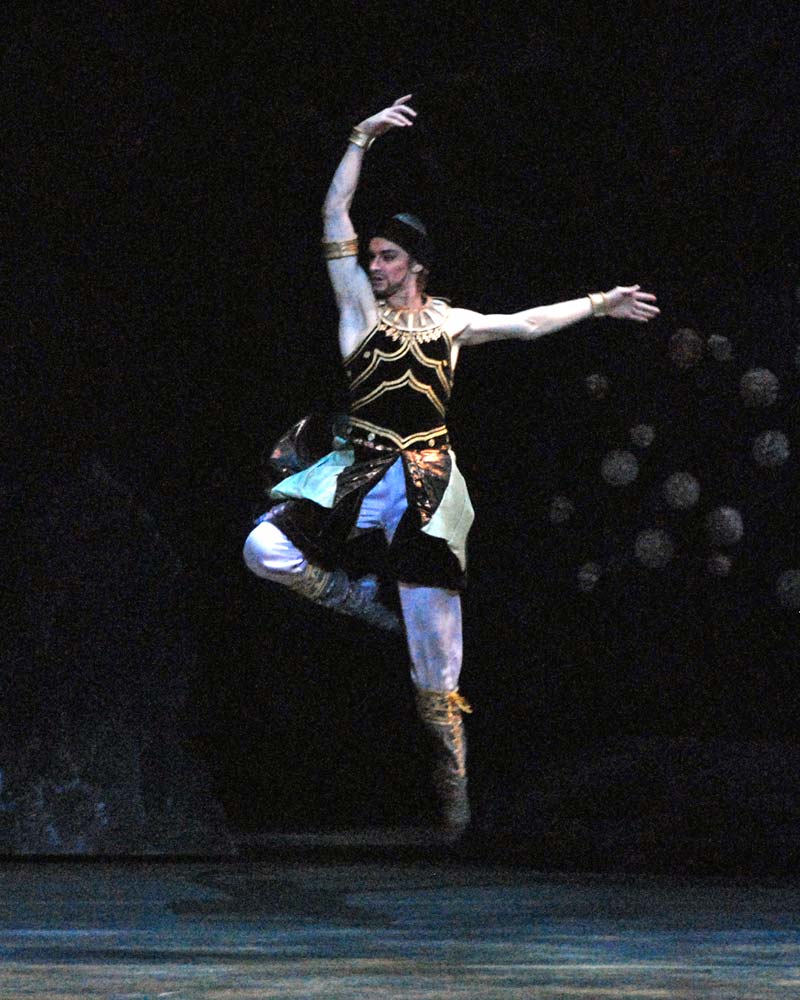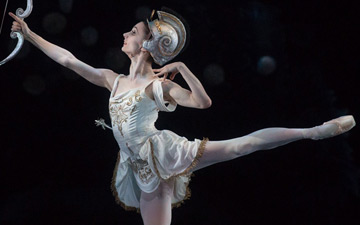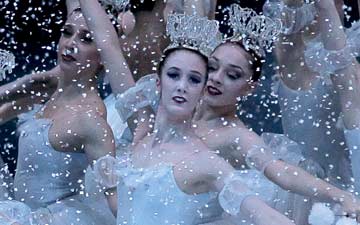
© MIRA. (Click image for larger version)
American Ballet Theatre
Sylvia
New York, Metropolitan Opera House
26 June 2013
www.abt.org
Sylvia, or the Pleasures of Style
There are ballets, like Swan Lake or Serenade, that can be enjoyed at face value, and others, like Alexei Ratmansky’s Namouna or Ashton’s Les Rendezvous, that benefit from a bit of stylistic distance. They comment and play with the art’s ideosyncracies, with affection and a touch of nostalgia. They can seem superficial or silly – and perhaps they are, in way – but the underlying love for ballet’s past is its own reward. For me, Frederick Ashton’s Sylvia falls into this category. There are great Sylvias – Gillian Murphy comes to mind – but one doesn’t see this ballet mainly to be carried away by a ballerina’s interpretation. The sets, music, and choreographic tableaux are all of a piece. Like a Fabergé egg with a tiny golden bird inside, Sylvia is decadent, a bit indulgent, but delightful.
American Ballet Theatre has been performing this 1952 ballet – made for Margot Fonteyn at the height of her powers – since 2005. The story is slight: Sylvia, a nymph devoted to the goddess of the hunt, is struck by Eros’s arrow. She falls in love with a handsome shepherd (Aminta), only to be carried off by an evil hunter (Orion). Not easily vanquished, she seduces Orion, fills him with drink, and, with Eros’s help, is spirited away, back into Aminta’s arms. Everyone rejoices. ABT’s lush rococo sets and costumes are a replica of the originals, designd by the British artists Robin and Christopher Ironside. The designs are intentionally old-fashioned, quaint, many-layered, full of drapery and chiaroscuri that turn the stage into a lavish popup book. The first tableau, a sylvan glade with a stony outcrop, reveals a little bridge in the background and a three-tiered fountain topped by a statue of Eros. The statue later turns out – surprise! – to be a dancer slathered in white body paint. The second act takes place in a kind of orientalist fantasy-land, Cairo by way of the the Moulin Rouge, with palm trees and grottoes and a fancy tent belonging to the cartoonish bad-guy, Orion. In the third tableau, to which the heroine is conveyed via a handsome sailing boat, a pantheon-like temple overlooks a glimmering sea. A postcard image of Ancient Greece. The costumes, fetching pseudo-classical tunics (loosely) inspired by Greek and Roman fashion, are chic and flattering. Roberto Bolle, who danced the role of Aminta on June 25 has never looked more handsome than in his thigh-and-shoulder-baring shepherd’s tunic in the first scene.

© MIRA. (Click image for larger version)
Indeed, Aminta is probably Bolle’s finest part. His calendar-boy looks and shy smile are perfectly suited to a role that the historian David Vaughan has described in his book Frederick Ashton and his Ballets as an “ineffectual hero,” a character who is seen but barely heard. His main purpose in the ballet is to be gazed upon, not only by the audience but by the heroine, Sylvia, as he lies in a enticing pose, mortally wounded by her wayward arrow. The steps Ashton has devised for Aminta have a similar purpose: he rises to his tip-toes, stretching his body to the fullest, and lifts his foot to his knee (passé), then does it again with the other leg, then executes a little swivel followed by a pirouette, all at a deliberate pace, so that he may be admired from every angle. Like the boy in Jerome Robbins’ Afternoon of a Faun, Aminta is an esthetic ideal, an essence: innocent, virile beauty and the promise of love.
The lovers have only one real pas de deux, in the final act, and here again Ashton gives the gentle shepherd limpid combinations of steps, almost exaggeratedly classical, which Bolle executes with simplicity and grace. As usual, he surpasses himself in the partnering, carrying his ballerina (Polina Semionova) onstage in an overhead lift with one arm as she lightly kneels on his shoulder. She looks as secure perched there as if she were standing on a pedestal. There is something almost moving about Bolle’s ability to glorify the women with whom he dances.

© MIRA. (Click image for larger version)
Semionova is a comely and stylish Sylvia, but doesn’t quite capture the brashness and attack Ashton has built into the role, especially in the first scene, all leaps and heroic arms raised in triumph. (It’s all there in Délibes soaring horn theme.) There are lovely moments, though, such as the pizzicato variation toward the end, with its many hops on pointe – while turning, traveling backward, or bobbing in place as the other leg executes little circles in the air. Semionova polishes these off with velvety softness and apparent ease. And she’s sensual – if perhaps not quite ironic enough – in the sexy dance-hall number with which which she seduces her captor, plying him with drink all the while. Ashton’s tongue-in-cheek exotica in this scene – complete with slaves in bright pantaloons performing a pseudo-oriental acrobatic duo – is one of the ballet’s many silly pleasures.
More than anything, one enjoys Sylvia for the music – shimmering, descriptive, crammed with memorable melodies, and constantly changing. (The ABT orchestra plays it with remarkable verve.) Clearly, Ashton was delighted by Délibes’s score as well. For each new color in the score, Ashton has created a corresponding set piece, from the frolicking fauns and dryads of the first scene – so reminiscent of The Dream – to a pretty folk dance built out of the famous “Fred step” for a group of peasants, and the vaudevillian chorus-line of the finale. Nothing is meant to be taken too seriously in this ballet, not even love.

















You must be logged in to post a comment.